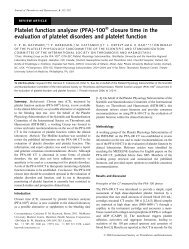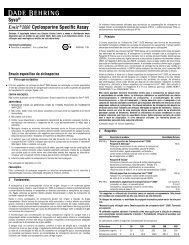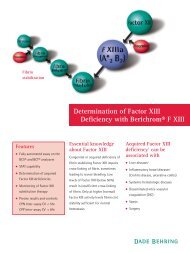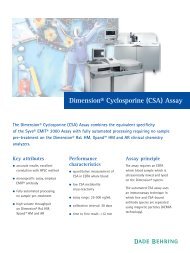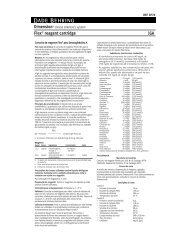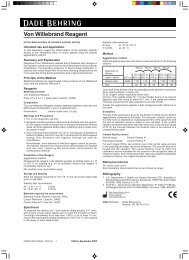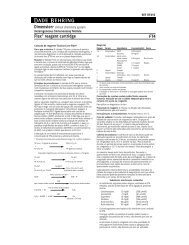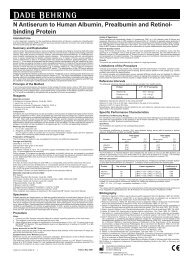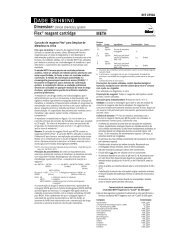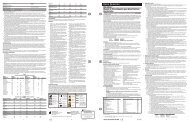Enzygnost* Anti-HBc monoclonal - Medcorp
Enzygnost* Anti-HBc monoclonal - Medcorp
Enzygnost* Anti-HBc monoclonal - Medcorp
You also want an ePaper? Increase the reach of your titles
YUMPU automatically turns print PDFs into web optimized ePapers that Google loves.
Composition<strong>Enzygnost*</strong> <strong>Anti</strong>-<strong>HBc</strong> <strong>monoclonal</strong> (test plate): Microtitration plate coated with geneticallyengineered hepatitis B core antigen.<strong>Anti</strong>-<strong>HBc</strong>/POD Conjugate <strong>monoclonal</strong>: Monoclonal anti-<strong>HBc</strong>, peroxidase (POD)-conjugated.Preservative: phenol (max. 1 g/L)Conjugate Buffer (anti-<strong>HBc</strong> <strong>monoclonal</strong>) Tris Buffer containing Boviserin ® and Tween 20.Preservative: phenol (max. 1 g/L)<strong>Anti</strong>-<strong>HBc</strong> Control Serum, negative: Human serum, stabilised, nominal absorbance: ≥ 0.7 APreservatives: amphotericin (approx. 5 mg/L), gentamicin (approx. 100 mg/L)<strong>Anti</strong>-<strong>HBc</strong> Control Serum, positive: Human serum, stabilised, nominal absorbance: ≤ 0.1 APreservatives: amphotericin (approx. 5 mg/L), gentamicin (approx. 100 mg/L)Washing Solution POD (concentrate): Phosphate buffer solution containing Tween.Preservative: phenol (max. 1 g/L)Buffer/Substrate TMB: Hydrogen peroxide (approx. 0.1 g/L) in acetate buffer solutionPreservative: n-butanol (approx. 1%)Chromogen TMB: Tetramethylbenzidine dihydrochlorideStopping Solution POD: 0.5 N sulphuric acidWarnings and Precautions1. For In vitro diagnostic use.2. Each individual blood donation for use in manufacture of the control sera is tested for HBsAg,anti-HCV, anti-HIV1 and anti-HIV2. Only donations with negative findings are used formanufacture.Nevertheless, since absence of infectious agents cannot be proven, all materials obtainedfrom human blood should always be handled with due care, observing the precautionsrecommended for biohazardous material 6 .3. It is advisable to wear protective gloves throughout the entire test procedure.4. For disposal, it is recommended that solid infectious materials should be autoclaved for atleast one hour at +121 °C. All aspirated liquids should be collected in two receptaclesconnected in series, which should both contain a disinfectant suitable for inactivatingpathogenic human viruses. The concentrations and times specified by the manufacturer mustbe observed.Preparation of theReagentsBring all the reagents and samples to +18 to +25 °C before beginning the test (without removingthe test plate from its container).For each test plate, dilute 20 mL of Washing Solution POD to 400 mL with distilled or deionized water.Working Chromogen Solution: For each test plate, dilute 1 mL of Chromogen TMB with 10mL of Buffer/Substrate TMB in the empty plastic bottle supplied with the kit (= WorkingChromogen Solution) and store closed and protected from light. Rinse the bottle thoroughly withdistilled water after use.For technical reasons (overfill) it is not permissible to pour together the full contents of theChromogen TMB vial and of the Buffer/Substrate TMB vial.Working Conjugate Solution: For each test plate add 0.5 mL of <strong>Anti</strong>-<strong>HBc</strong>/POD Conjugate toan original vial (12.5 mL) of Conjugate Buffer (<strong>Anti</strong>-<strong>HBc</strong> <strong>monoclonal</strong>) (1+25). Shake gently tomix, avoiding the formation of foam.Storage and StabilityStored unopened at +2 to +8 °C, all components of the <strong>Enzygnost*</strong> <strong>Anti</strong>-<strong>HBc</strong> <strong>monoclonal</strong>combination pack remain stable up to the dates of expiry given on the labels.For complete stability and storage data see Table 1 in the Appendix.OUWE G13 C0541 (879) CS/R 3



